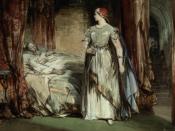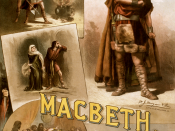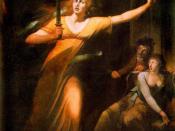The Renaissance play The Tragedy of Macbeth, written by William Shakespeare, truly demonstrated a compelling tale of greed, power, and jealousy. The play revealed the turn of a good nobleman into a powerful and greedy king. It showed audiences how one crime led to another and eventually to a gruesome melee. Throughout the tragedy there appeared to be a reoccurring theme stated finest as appearances are deceiving. The audience is first introduced to the theme in the first scene of the play where the witches said the profound phrase, "Fair is foul, and foul is fair" (I, i, 10). The Tragedy of Macbeth continued to present the idea of images being deceivingly different from the actual appearance.
First, in Act I, the key phrase, "Fair is foul, and foul is fair" (I, i, 10), was expressed as an example of the constant theme. That main phrase foreshadowed how appearances could deceive because, in essence, it stated that good was bad and bad was good.
At first, the audience was shown that Macbeth was a gentle nobleman who would despise the thought of killing. However, Lady Macbeth, his wife, was greedy from the start of the play and continued to persuade her husband into killing the king, Duncan. The phrase foreshadowed the change in characters as well, because Macbeth was the "fair" individual, as his wife would start as the "foul" one. Further on, Banquo asked Macbeth, "Good sir, why do you start, and seem to fear / Things that do sound so fair?" (I, iii, 51-52) after he was told news by witches that he would be king. He was asking why he was frightened by good news; meanwhile, the audience knew that the witches were pernicious souls. In that passage, the appearance or sound of...


